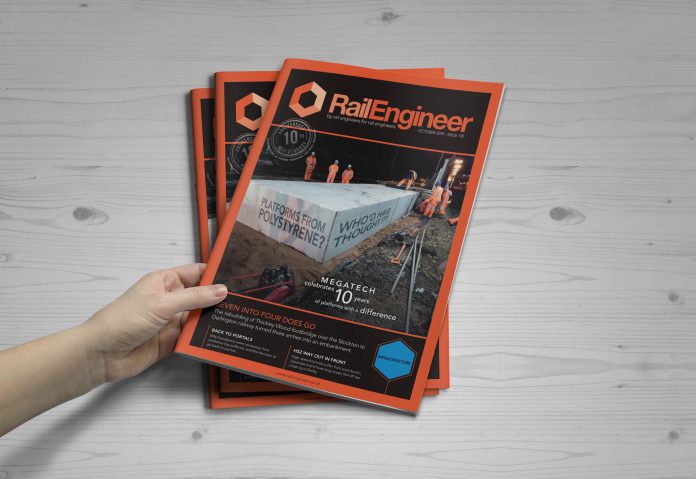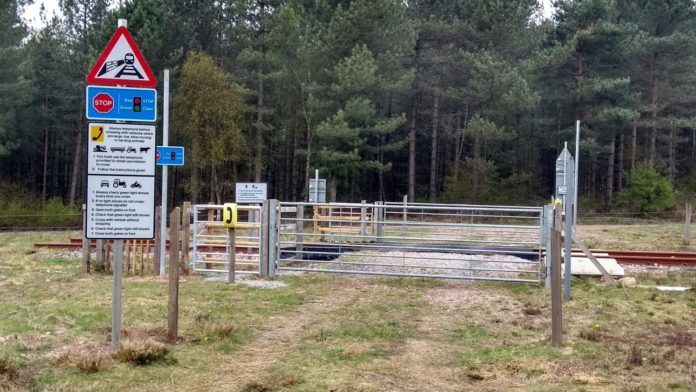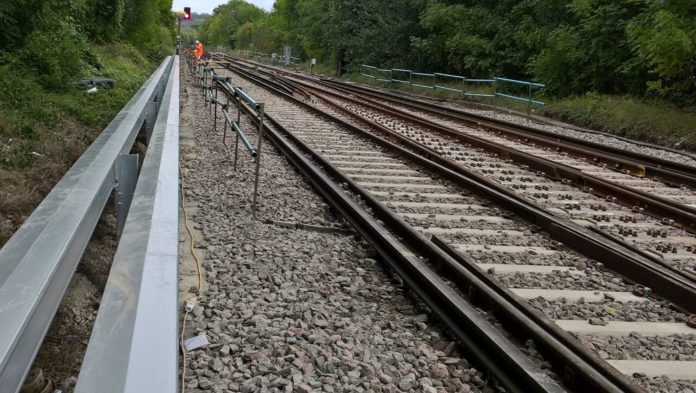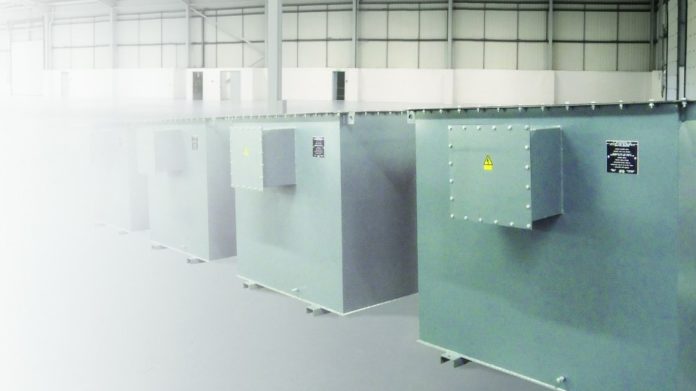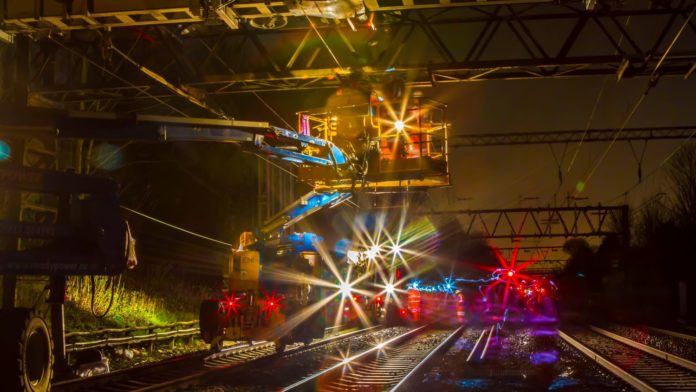Thickley Wood footbridge at Shildon, County Durham, is unusual but reflects the growth and decline of the local coalfields. Spanning the historic Stockton & Darlington Railway, this bridge dates from 1857, at which time it was a cast iron span of 16.5 metres over the Darlington to Bishop Auckland line.
As the collieries expanded to meet the demands of Victorian Britain’s industries, so were additional sidings required. In 1868, a second wrought iron girder span of 10.9 metres was added to the south and, in 1875, four additional wrought iron lattice spans, one of 7.7 metres and three of 15.2 metres, were added to the south. At this time there were two running lines and six sidings passing below the bridge.
Although, there had been 27 miles of sidings around Shildon at their peak, by 2018, there were just two running lines and a single siding passing beneath the bridge, with the first three spans being redundant.

The bridge carries a footpath, much used by walkers and recreational visitors to Thickley Wood. The bridge is just 40 metres to the east of ‘Locomotion’, part of the National Railway Museum.
The oldest section, ‘span 7’, is cast iron and is listed Grade II because it is “a single casting of exceptional length”. This includes a maker’s plate, ‘HARRIS MDCCCLVII MAKER’. John Harris was the Stockton & Darlington Railway’s resident engineer from 1836 to 1844. He then became self-employed, and one of his many businesses was Hopetown foundry, in Darlington, where he cast this bridge.
It was recognised by Network Rail that parts of the bridge were in very poor condition and that substantial investment would be required to return it to full strength.

Local concerns
The 1825 Stockton & Darlington Railway was the birthplace of Britain’s railway system and was designated in 2018 by Historic England as a Heritage Action Zone. This is part of a five-year project to unlock potential investment into the structures and environment surrounding the Stockton & Darlington Railway with the aim of creating an iconic tourist attraction that will increase economic growth in the surrounding area. As a result, any works around it have the potential to be controversial.
In 2018 Network Rail submitted an application for local authority planning consent for the works as they would affect a listed structure. This described the removal of the redundant spans replacing these with an embankment and the refurbishment of the remaining spans. This being the only realistic economic solution.
These proposals met with much criticism locally. There were concerns that the work would destroy the character of the bridge and the wish was expressed that the bridge should be preserved especially leading up to the bicentenary of the S&DR.

Jonny Ham, Network Rail’s project manager, explained: “The design stage was a real challenge and we treated the whole bridge as a listed structure, even though it was only the original three spans that were protected.
“We were conscious that we wanted to be sympathetic to the design of the bridge, so we replicated the original metal latticework in the railings of the new ramped access, and painted the bridge in its original shade of grey”.
In its submission, Network Rail commented: “By maintaining different styles of bridge across the spans, the appearance of the bridge will alter, but this will tell a story of the development of the railway across a period of time. The appearance of the bridge will reflect one altered over the years to accommodate an ever-changing railway and local landscape.”
In March 2018, both Shildon Town Council and Durham County Council considered the application and raised no objections to Network Rail’s proposals.
Design
Leeds-based Construction Marine Ltd (CML) was awarded the £1.6 million contract for the works under its RCDP (Renewals Collaborative Delivery Programme) framework contract. The project at this point was at GRIP 3 (option selection) stage. CML’s Nigel Lea and Mark Anderson explained to Rail Engineer how the project was delivered.
CML prepared an options report, based on Network Rail’s remit, with several alternatives being considered for each of the bridge’s seven spans. Network Rail had liaised over a couple of years with Durham County Council to understand which options were likely to be acceptable at this sensitive location, and this guided the optioneering process.
CML prepared an options report, based on Network Rail’s remit, with several alternatives being considered for each of the bridge’s seven spans. Network Rail had liaised over a couple of years with Durham County Council to understand which options were likely to be acceptable at this sensitive location, and this guided the optioneering process.

There was prolonged and more detailed consideration on costing and practicality of the various options than is usual, to ensure that the planning application would be very detailed, and the logic fully justified.
The agreed solutions were:
- The four redundant 1875 lattice side-spans (1-4) would be removed and spans 1 to 3 replaced with an embankment. This was designed to be a reinforced earth structure, reducing fill requirements but also enabling its footprint to remain much the same as the original bridge, and fit within the adjacent boundary fencing of the ‘Locomotion’ museum;
- Span 4 would be replaced with a standard LM footbridge welded steel span. The original pier between spans 3 and 4 was to become an abutment, with new wing walls built from masonry recovered from the demolished piers. The reinforced embankment behind the abutment would be self-supporting but a compressible layer between fill and masonry would be provided to ensure that no thrust would be imposed on the slender pier;
- Span 5 (1868 span) would be retained and the wrought iron structure repaired and repainted, timber decking refurbished and full height parapet handrails installed;
- Span 6 would receive minor masonry repairs and have a lightweight in-situ concrete deck installed;
- Span 7 (the listed 1857 cast iron span), would have stitch repairs to its cast iron cross girders, making good poor historic repairs, and would be repainted. This, too, would have a lightweight concrete deck over the waterproofed jack arches, and improved parapets;
- In addition, a second embankment would be formed to provide a wheelchair-friendly access ramp up to span 7 from the former track bed, connecting with the foot and cycleway that connects the town to the museum. This was to be funded by Durham County Council and was designed to be easily removable as it occupies a former track bed that might at some point in the future be required should freight expansion take place.
Construction
Before works began at the end of August 2018, the CML project team met with representatives of Network Rail, National Railway Museum, landowners and Friends of the Stockton & Darlington Railway, to fully explain the scope and timeline of the project.

Following initial site clearance operations, the team installed a temporary 120-metre access road from the site compound, which was established adjacent to the ‘Locomotion’ access road. This was designed to cope with the bulk earthworks deliveries and bridge delivery. Good, regular liaison with the museum team ensured deliveries of plant and materials did not affect their peak visitor periods. Crane pads and a large laydown area were constructed to store the removed and new spans.
The siding into ‘Locomotion’ through span 4, was blocked throughout the project.
On 15/16 September, the four lattice spans were lifted out by a 150-tonne LTM 1150 Crane. The 10-tonne spans 1 and 2 were lifted out during the day and these placed in the laydown area. The crane then de-rigged and moved forward to lift out spans 3 and 4 during a 23:00-06:00 possession of the Darlington – Bishop Auckland line.
During November to January, the new reinforced earth embankment was designed and constructed by Maccaferri using its Terramesh system. This combined the use of galvanised steel cages to face the embankment with geo-fabric tensile straps installed in layers as the embankment was constructed.
The fill for the embankment facing was locally sourced gabion stone, tipped adjacent to the work areas and loaded into the 3000mm wide facing baskets, to create a drystone wall appearance. The central fill was placed by 25-tonne and 13-tonne excavators, a D6 bulldozer and dumptrucks and compacted in 150mm layers by rollers and plates.

The geotextile straps were installed in sequence with the erection of the facing baskets. Paragrid 80/05 reinforcement was laid every other layer at the face edge. As the works proceeded, temporary scaffold edge protection was attached to the baskets.
Pockets of pre-seeded soil mixture were incorporated into the upper section of the face, which will result in grass-covered walls. The lower will remain stone-faced, matching the adjacent walls of ‘Locomotion’. The new access ramp at the north end was constructed using a mix of reinforced earth and, at the lower ends, natural fill. The steel footway fencing of the south embankment incorporates a lattice design, reflecting the original girders, the north ramp has steel, five-rail estate fencing.
The masonry wing walls and repairs to other part of the structure were carried out by a team from Darlington-based D France Masonry. They constructed the walls using recovered stone from the demolished piers, matching exactly the historic masonry.
The new span 4 was fabricated by Britcon Engineering Services at Scunthorpe and the pre-cast retention units by Ebor Concrete. These were installed in possession by a Liebherr 160-tonne crane – the bridge unit weighed 9 tonnes and this planned lift was delayed by two weeks due to high winds.
The repairs to span 5 were carried out by HS Carlsteel Engineering. This span has a timber deck, which was refurbished using timbers recovered from the demolished spans 1-4.
Spans 5 and 7 were wet blasted to Sa2.5, and an M24 paint system applied by Bagnalls, in a series of Saturday and weeknight rules of the route possessions of the Darlington – Bishop Auckland line.
Following the blasting, further cracking was identified in the bottom flange of the cast main beams. A supplementary planning consent for additional repairs to the listed structure was quickly agreed. These fractures, together with the known problems with the cross girders, were repaired using the Metalock stitch system.
The heritage of the site and structure were very much in the CML teams mind during the project. In addition to the use of recovered timber and masonry, the redundant lattice span 4 was donated to the Friends of the Stockton & Darlington Railway. Ross Chisholm explained that this is in store at the Weardale Railway but that they hope to use this as a training project for the next generation of tradespeople. Once restored it will be displayed within the Heritage Action Zone.
The opening of the completed bridge took place on 28 March, attended by 30 representatives from stakeholding groups. Despite their initial concerns at the scope of the works, the Friends of the Stockton & Darlington Railway complimented Network Rail and CML, describing the bridge as a “good job well done” and were very pleased to have been involved in the project.























